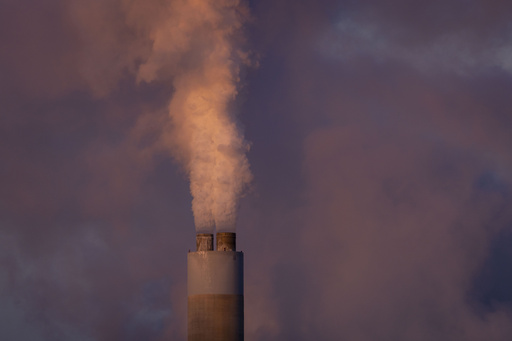
CHEYENNE, Wyo. — The push for underground carbon dioxide storage from power plants and industrial operations may encounter reduced federal backing under the current administration. However, specialists and advocates believe that the demand for such carbon capture technology will persist, particularly as utilities strive to meet various state-level climate objectives.
Former President Trump championed an aggressive fossil fuel strategy and withdrew the U.S. from the Paris climate accord aimed at curbing global warming. In line with this, his energy secretary, Chris Wright, has indicated a focus on maintaining “affordable, reliable and secure energy,” which lacks emphasis on carbon capture or zero-carbon energy goals.
Despite skepticism from various conservative think tanks and environmental organizations toward carbon capture, its future is not entirely grim. Under President Biden, the sector received a considerable $12 billion influx through increased tax incentives and funding derived from the Inflation Reduction Act and the Bipartisan Infrastructure Law. Numerous projects are now spread across the country, including many located in Republican-majority states, which may deter lawmakers from proposing budget cuts that could affect their development, according to Rohan Dighe, an analyst at Wood Mackenzie.
Nonetheless, Dighe cautions that a broader shift away from “environmental, social and governance” (ESG) investments could dampen carbon capture momentum, suggesting that we might witness fewer announcements and activities surrounding new projects due to waning interest in decarbonization efforts.
Carbon capture technology involves isolating carbon dioxide from emissions produced by power stations and industrial facilities, with the aim of either sequestering it underground to mitigate climate change or utilizing it to enhance oil extraction in aging fields.
In Wyoming, a state heavily reliant on coal, carbon capture has wide-ranging support. It hosts various projects, such as an ExxonMobil facility that extracts CO2 from sour gas wells for enhanced oil production, alongside another initiative that tests underground CO2 storage. In 2021, Republican Governor Mark Gordon committed to making Wyoming carbon neutral and even “carbon negative,” identifying carbon capture as a key component of that strategy. Wyoming notably became one of the first states to oversee its own carbon dioxide injection regulations, a distinction it now shares with Louisiana, North Dakota, and West Virginia.
Yet, skepticism has started creeping into Wyoming’s discourse, particularly as some lawmakers, emboldened by Trump’s return to office, question the necessity of greenhouse gas goals. One lawmaker introduced a bill termed “Make Carbon Dioxide Great Again,” which aimed to freeze carbon capture initiatives and repeal a 2020 regulation mandating utilities to assess the costs of implementing carbon capture at fossil fuel plants; however, the bill failed to garner traction among peers.
Despite these challenges, Governor Gordon remains steadfast in supporting carbon capture to safeguard Wyoming’s coal sector. With eighteen states that collectively comprise a significant portion of Wyoming’s coal market advocating for renewable energy and carbon neutrality, Gordon’s spokesperson noted that “to maintain that market, we have to adopt carbon capture.”
The substantial federal funding allocated for carbon capture under Biden has propelled numerous projects nationwide through the Department of Energy’s CarbonSAFE program, with several initiatives situated in Wyoming alone.
The future of the “45Q” tax credit for carbon capture projects raises concern for many in the industry, including the Carbon Capture Coalition, which consists of over 100 organizations, unions, and companies advocating for the technology. They have urged Congress to protect the tax incentive established in the Inflation Reduction Act.
Currently, the Petra Nova facility outside Houston stands as the only power plant in the U.S. operating carbon capture on a commercial scale, although there’s potential for more facilities to emerge in the coming years. Federal support has facilitated the launch of 270 carbon capture projects across the nation in recent years, according to coalition representatives.
Republicans have made numerous attempts to repeal components of the Inflation Reduction Act during their prior minority Senate status. With their current control of the Senate, House, and presidency, such repeals appear more feasible. Support from conservative entities like the Heritage Foundation, which has historically opposed carbon capture, could impact future policy decisions. They argue that imposing carbon capture requirements on energy facilities could prove expensive, especially with the growing demand driven by electric vehicles.
Some conservatives also express concern that expanding the necessary infrastructure for carbon capture might encroach upon private property rights. A report by the Heartland Institute labeled carbon capture and storage projects as financially motivated strategies attempting to profit from an issue that some argue is overstated.
Conversely, various environmental groups, including Earthjustice, view carbon capture skeptically, believing it may serve as justification for the continued use of fossil fuels. The Carbon Capture Coalition, however, sees it as a pragmatic solution, acknowledging that a transition to completely carbon-free energy production will take time. They maintain that even in the face of Trump’s fossil fuel advocacy, there remains a robust demand for carbon capture technology both nationally and globally.
To remain competitive, both domestically and internationally, U.S. industries must invest in innovative solutions like carbon management, the coalition argues, demonstrating that the dialogue surrounding carbon capture is far from over.

